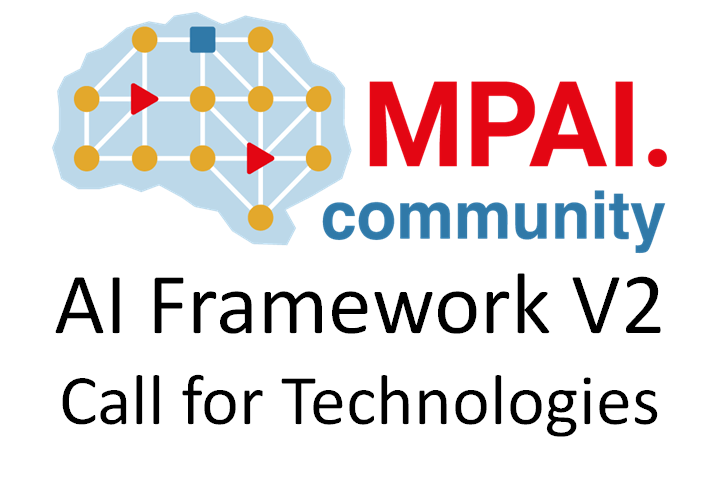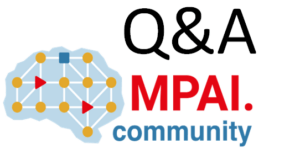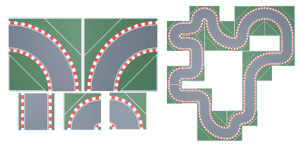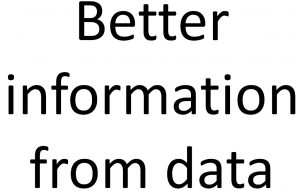A foundational element of the MPAI architecture is the fact that monolithic AI applications have some characteristics that make them undesirable. For instance, they are single-use, i.e., it is hard to reuse technologies used by the application in another application and they are obscure, i.e., it is hard to understand why a machine has produced a certain output when subjected to a certain input. The first characteristic means that it is hard to make complex applications because an implementer must possess know-how of all features of the applications and the second is that they often are “unexplainable”.
MPAI launched AI Framework (AIF), its first official standardisation activity in December 2020, less than 3 months after its establishment. AIF is a standard environment where it is possible to execute AI Workflows (AIW) composed of AI Modules (AIM). Both AIWs and AIMs are defined by their function and their interfaces. AIF is unconcerned by the technology used by an AIM but needs to know the topology of an AIW.
Ten months later (October 2021)the MPAI-AIF standard was approved. Its structure is represented by Figure 1.
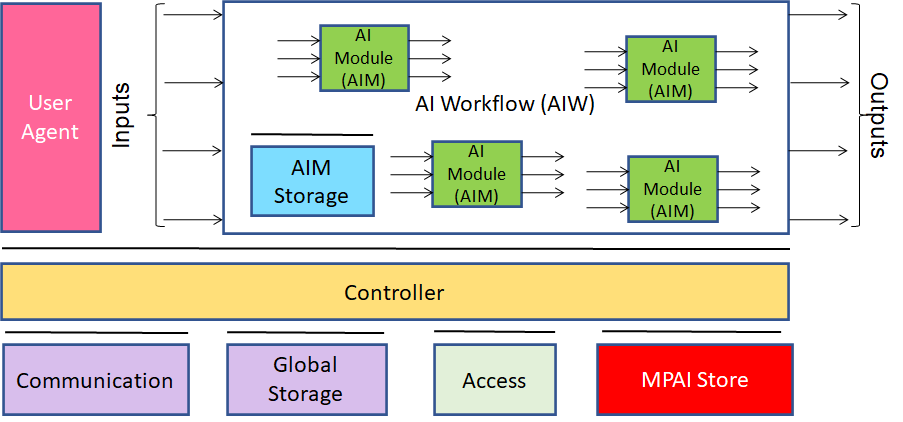
Figure 1 – The MPAI-AIF Reference Model
MPAI’s AI Framework (MPAI-AIF) specifies the architecture, interfaces, protocols, and Application Programming Interfaces (API) of the AI Framework (AIF), an environment specially designed for execution of AI-based implementations, but also suitable for mixed AI and traditional data processing workflows.
The AIF, the AIW and the AIMs are represented by JSON Metadata. The User Agent and the AIMs call the Controller through a set of standard APIs. Likewise, the Controller calls standard APIs to interact with Communication (a service for inter-AIM communication), Global Storage (a service for AIMs to store data for access by other AIMs) and the MPAI Store (a service for downloading AIMs required by an AIW). Access represents access to application-specific data.
Through the JSON Metadata, an AIF with appropriate resources (specified in the AIF JSON Metadata) can execute an AIW requiring AIMs (specified in the AIF JSON Metadata) that can be downloaded from the MPAI Store.
The MPAI-AIF standard has the following main features:
- Independence of the Operating System.
- Modular component-based architecture with specified interfaces.
- Encapsulation of component interfaces to abstract them from the development environment.
- Interface with the MPAI Store enabling access to validated components.
- Component can be implemented as software, hardware or mixed hardware-software.
- Components: execute in local and distributed Zero-Trust architectures, can interact with other implementations operating in proximity and support Machine Learning functionalities.
The MPAI-AIF standard achieves much of the original MPAI vision because AI applications:
- Need not be monolithic but can be composed of independently developed modules with standard interfaces
- Are more explainable
- Can be found in an open market.
Feature #6 above is a requirement, but the standard does not provide practical means for an application developer to ensure that the execution of the AIW takes place in a secure environment. Version 2 of MPAI-AIF intends to provide exactly that. As MPAI-AIF V1 does not specify any trusted service that an implementer can rely on, MPAI-AIF V2 identifies specific trusted services supporting the implementation of a Trusted Zone meeting a set of functional requirements that enable AIF Components to access trusted services via APIs, such as:
- AIM Security Engine.
- Trusted AIM Model Services
- Attestation Service.
- Trusted Communication Service.
- Trusted AIM Storage Service
- Encryption Service.
Figure 1 represents the Reference Models of MPAI-AIF V2.
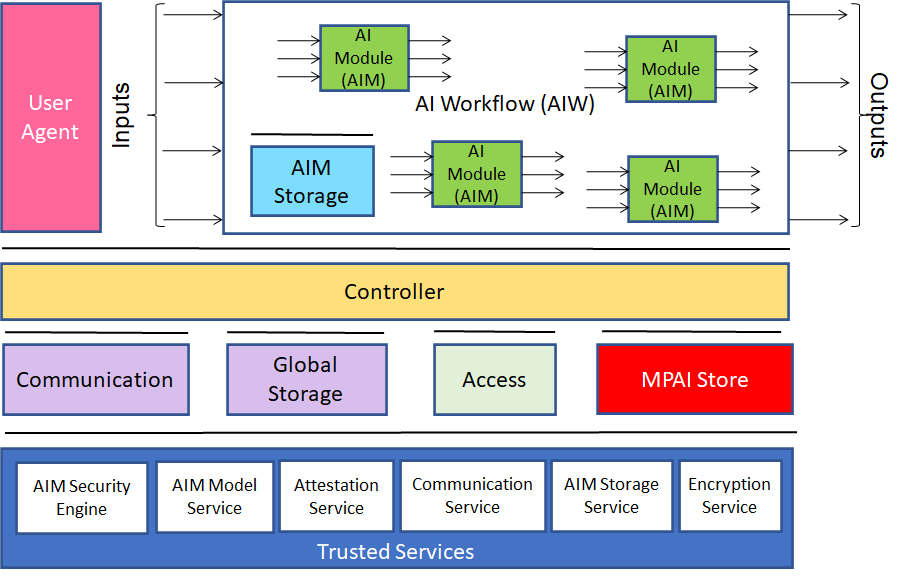
Figure 2 – Reference Models of MPAI-AIF V2
The AIF Components shall be able to call Trusted Services APIs after establishing the developer-specified security regime based on the following requirements:
- The AIF Components shall access high-level implementation-independent Trusted Services API to handle:
- Encryption Service.
- Attestation Service.
- Trusted Communication Service.
- Trusted AIM Storage Service including the following functionalities:
- AIM Storage Initialisation (secure and non-secure flash and RAM)
- AIM Storage Read/Write.
- AIM Storage release.
- Trusted AIM Model Services including the following functionalities:
- Secure and non-secure Machine Learning Model Storage.
- Machine Learning Model Update (i.e., full, or partial update of the weights of the Model).
- Machine Learning Model Validation (i.e., verification that the model is the one that is expected to be used and that the appropriate rights have been acquired).
- AIM Security Engine including the following functionalities:
- Machine Learning Model Encryption.
- Machine Learning Model Signature.
- Machine Learning Model Watermarking.
- The AIF Components shall be easily integrated with the above Services.
- The AIF Trusted Services shall be able to use hardware and OS security features already existing in the hardware and software of the environment in which the AIF is implemented.
- Application developers shall be able to select the application’s security either or both by:
- Level of security that includes a defined set of security features for each level, i.e., APIs are available to either select individual security services or to select one of the standard security levels available in the implementation.
- Developer-defined security, i.e., a combination of a developer-defined set of security features.
- The specification of the AIF V2 Metadata shall be an extension of the AIF V1 Metadata supporting security with either or both standardised levels and a developer-defined combination of security features.
- MPAI welcomes the submission of use cases and their respective threat models.
MPAI has rigorously followed its standard development process in producing the Use Cases and Functional Requirements summarised in this post. MPAI has additionally produced The Commercial Requirements (Framework Licence) and the text of the Call for Technologies.
Below are a few useful links for those wishing to know more about the MPAI-AIF V2 Call for Technologies and how to respond to it:
- The “About MPAI-AIF” web page provides some general information about MPAI-AIF.
- The MPAI-AIF V1 standard can be downloaded from here.
- The 1’20” video (YouTube and (non-YouTube) concisely illustrates the MPAI-AIFV2 Call for Technologies.
- The slides and the video registration of the online presentation (YouTube, non-YouTube) made at the 11 July online presentation give a complete overview of MPAI-AIF V2.
The MPAI secretariat shall receive the responses to the MPAI-AIF V2 Call for Technologies by 10 October 2022 at 23:39 UTC. For any need, please contact the MPAI secretariat.
